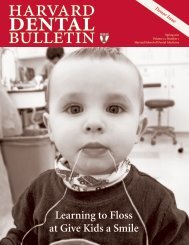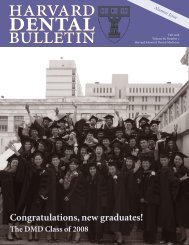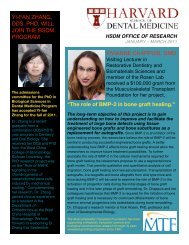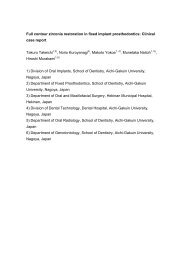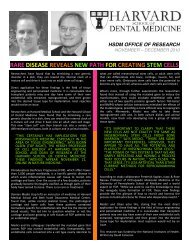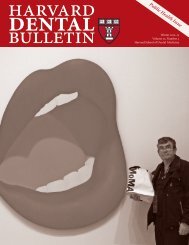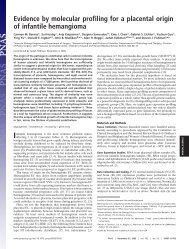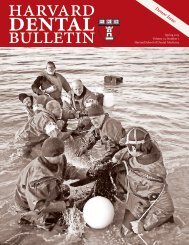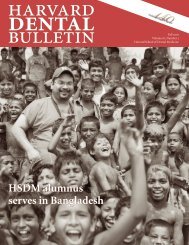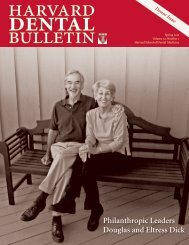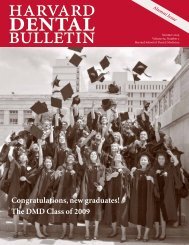Research Issue - Harvard School of Dental Medicine
Research Issue - Harvard School of Dental Medicine
Research Issue - Harvard School of Dental Medicine
You also want an ePaper? Increase the reach of your titles
YUMPU automatically turns print PDFs into web optimized ePapers that Google loves.
harvarddentalbulletinWinter 2010–11Volume 70Number 3<strong>Research</strong> FocusHSDM <strong>Research</strong> Targets OsteoarthritisStudies by Yefu Li and Dorothy Pazin hold promise for therapy and prevention.Osteoarthritis (OA) represents an enormous socioeconomicburden. Persons with the disease suffer from chronic the possibility <strong>of</strong> using this extracellular part <strong>of</strong> DDR2 as a“This very encouraging information prompts us to think aboutpain that greatly reduces quality <strong>of</strong> life and costs the economy therapeutic agent for the treatment <strong>of</strong> OA,” says Li. “We planmore than $125 billion per year in lost working days and medicaland surgical costs. The complicated causes <strong>of</strong> the disease OA progression in a mouse model <strong>of</strong> OA.” If successful, says Li,to test whether the extracellular part <strong>of</strong> the receptor can delayand largely unknown mechanisms by which OA ensues make this research will confirm the DDR2-collagen interaction as ait very difficult to identify effective therapeutic targets for novel target for OA therapy and serve as a prelude to evaluatingtreatment. Recently, several drugs usedfor the treatment <strong>of</strong> arthritic pain havebeen found to have severe side effects,and some, such as Vioxx, have beenwithdrawn. Therefore, new therapeuticagents for the treatment <strong>of</strong> osteoarthritisare urgently needed, and researchersat HSDM are pursuing promising pathstoward this end.treatmentOne <strong>of</strong> those researchers is Yefu Li, an HSDM assistant pr<strong>of</strong>essor<strong>of</strong> developmental biology. Although the initial events <strong>of</strong> OAare diverse, he notes, the pathologic progression <strong>of</strong> the diseasefollows a consistent pattern (articular cartilage degeneration).Thus, an understanding <strong>of</strong> the molecular pathway underlyingthis pathologic progression is critical in treating this disease.In the past few years, Li and colleagues have been using mouseOA models and human OA cartilages to investigate molecularmechanisms responsible for the articular cartilage degeneration.The team discovered the existence <strong>of</strong> a novel pathwaymediated by activation <strong>of</strong> a cell membrane receptor for type IIcollagen (DDR2) that leads to the irreversible loss <strong>of</strong> cartilagein mouse models <strong>of</strong> OA. Since activation <strong>of</strong> DDR2 requiresbinding <strong>of</strong> the receptor to type II collagen, blocking interaction<strong>of</strong> DDR2 with the type II collagen can inhibit activation<strong>of</strong> DDR2. This strongly suggests that agents that interrupt theinteraction <strong>of</strong> the DDR2 with type II collagen can inhibit thispathway.The complicated causes <strong>of</strong>osteoarthritis and the largelyunknown mechanisms by whichit ensues make it very difficultto identify effective therapeutictargets for treatment.the extracellular part <strong>of</strong> the DDR2 asa possible therapeutic for human OA.preventionDorothy Pazin, a 2010–2011 HSDMDean’s Scholar, is pursuing a pathtoward OA prevention through aninvestigation <strong>of</strong> the developmentalorigins <strong>of</strong> the meniscus. A fibrocartilaginousdisc in the knee, the meniscusprotects the joint from damage by distributing weight andabsorbing shock that occurs during normal knee movement.Damage to the meniscus by sports injury, traumatic accident,and normal wear and tear is common and is a predictor<strong>of</strong> future development <strong>of</strong> osteoarthritis. Efforts to repair themeniscus are largely unsuccessful because <strong>of</strong> the poor healingability <strong>of</strong> the tissue and the lack <strong>of</strong> effective treatment strategies.“Normal tissue repairs itself, but the meniscus has avery limited capacity for repair and regeneration,” says Pazin,a postdoctoral fellow in the laboratory <strong>of</strong> Vicki Rosen, head<strong>of</strong> the Department <strong>of</strong> Developmental Biology. Given that thesequence <strong>of</strong> events that occurs during repair <strong>of</strong> other musculoskeletaltissues <strong>of</strong>ten recapitulates developmental processes, theresearchers hypothesize that the regulatory molecules that controlmeniscal morphogenesis may be effective meniscal repairagents. Pazin and her team expect that their work will lead to agreater understanding <strong>of</strong> the embryonic origins <strong>of</strong> the meniscusand the genes and signaling pathways that control its development.These answers will lead to potential therapeutics formeniscal injury and to preventive strategies for osteoarthritis.H10



